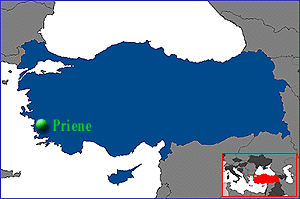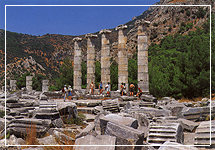PRIENE
 Priene, now known as Güllübahçe, was an ancient city of
Ionia in Western Anatolia situated some 20 km from Söke. Excavations here were begun by
Carl Human in 1895 and completed by Th. Wiegand in 1898. The ruins of Priene present one
of the most striking examples of the grid type of town-planning associated with the name
of Hippodamos. The plan of Priene was based on that of Athens and, as the ancient town is
located on a slope at the foot of a great cliff of rock, the grid plan is displayed in all
its magnificence. Temples and other buildings were constructed on terraces in front of the
cliff. No one who visits this little city can fail to be impressed by the landscape and
the whole surrounding atmosphere. In spring it fills anyone who views it with the joy of
life. Priene, now known as Güllübahçe, was an ancient city of
Ionia in Western Anatolia situated some 20 km from Söke. Excavations here were begun by
Carl Human in 1895 and completed by Th. Wiegand in 1898. The ruins of Priene present one
of the most striking examples of the grid type of town-planning associated with the name
of Hippodamos. The plan of Priene was based on that of Athens and, as the ancient town is
located on a slope at the foot of a great cliff of rock, the grid plan is displayed in all
its magnificence. Temples and other buildings were constructed on terraces in front of the
cliff. No one who visits this little city can fail to be impressed by the landscape and
the whole surrounding atmosphere. In spring it fills anyone who views it with the joy of
life.
HISTORY OF PRIENE
T he
origin of Priene and the foundation of the city are ascribed to the Carians, the
indigenous population of the region, but legends are our only guide for the earliest days.
The oldest remains have been dated to the 6th century B.C., and it was on the territory of
Priene that the site of the Panionion was located. According to some sources, the Ionians
first arrived and settled here in the 11th century B.C. and the city was founded either by
Aegyptus of Athens or Philotas of Thebes. The city was one of the most influential cities
of the Ionian Confederacy and took part in the development of holidays and festivals in
honor of Poseidon Heliconios. Bias, one of the most eminent thinkers of ancient times
lived here. An electrum coinage is known to have been produced during this period. In the
7th century Priene came under Lydian rule and in the 6th century it was conquered by the
Persians, who were to exercise hegemony for over a century. Priene . contributed twelve
ships to the rising against the Persians. A naval battle took place off Lade in 494 B.C.,
with 353 Ionian triremes (ships propelled by galley-slaves at three banks of oars) against
600 Persian sailing-ships and Darius took his revenge by completely destroying the city. he
origin of Priene and the foundation of the city are ascribed to the Carians, the
indigenous population of the region, but legends are our only guide for the earliest days.
The oldest remains have been dated to the 6th century B.C., and it was on the territory of
Priene that the site of the Panionion was located. According to some sources, the Ionians
first arrived and settled here in the 11th century B.C. and the city was founded either by
Aegyptus of Athens or Philotas of Thebes. The city was one of the most influential cities
of the Ionian Confederacy and took part in the development of holidays and festivals in
honor of Poseidon Heliconios. Bias, one of the most eminent thinkers of ancient times
lived here. An electrum coinage is known to have been produced during this period. In the
7th century Priene came under Lydian rule and in the 6th century it was conquered by the
Persians, who were to exercise hegemony for over a century. Priene . contributed twelve
ships to the rising against the Persians. A naval battle took place off Lade in 494 B.C.,
with 353 Ionian triremes (ships propelled by galley-slaves at three banks of oars) against
600 Persian sailing-ships and Darius took his revenge by completely destroying the city.
The city possessed two harbours, but both of these became silted up by the alluvium
brought down by the Meander river. The new city was built on its present site in 350 B.C.
At that time the city lay at some distance from the sea and carried on its maritime
activity through the little port of Naulochus. Like the contemporary city of Pergamon, it
possessed a very fine urban layout and a magnificent view. Priene was noted for its peace
and prosperity, and never displayed the pride and arrogance of Ephesus. It remained a
lovely little city with a population of 4,000. The marble and bronze statues that adorned
the streets were painted in red and blue. It was attached to Athens and never played a
truly independent role in politics. In the 4th century B.C. Alexander the Great dedicated
a temple to Athena here. The city was occupied by the Gauls in 277 B.C., then, after after
passing for a time into the hands of the Seleucides, it was incorporated by King Attalos
into the Kingdom of Pergamon.
In 129 B.C. Priene became part of the Roman
province of Asia Minor. It was sacked by Mithridates, King of Pontus, in 88 and 84 B.C.,
but regained its former wealth and prosperity under the Emperor Augustus, whose cult was
performed in the temple of Athena and the Sacred Stoa. After this, the increasing distance
from the sea led to the decline of the city. Priene was the birthplace of Bias, one of the
seven sages of antiquity.
When Priene was besieged by the Persians and the
citizens began to flee from the city taking all their valuable possessions with them, Bias
remained unmoved. On being asked if he had no possessions he wished to save from the
enemy, he replied, "All my wealth is in my head" . Other famous pronouncements
of his are "Not to be able to participate in misfortune is the greatest
catastrophe." "Begin slowly but continue with vigour." "Action makes
the man."
Priene was also the birthplace of Archelaus, the
famous sculptor who, in the 3rd century B.C., adorned the city with his artistic creations
and went on to work in Pergamon towards 240 B.C. Priene appeared once again on the stage
of history in the Byzantine period as the seat of a bishop. It was captured by the Turks
in the l4th century, after which it continued its existence as an insignificant village.
Photographs by:Erdal Yazici,Gungor
Ozsoy,Haluk Ozozlu,Tahsin Aydogmus
Places to visit:
Related links:
|
|

